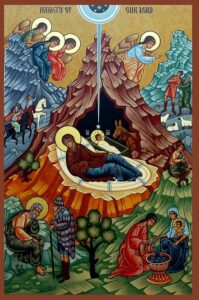 On this eve of the final Sunday before the celebration of the Nativity, the theme of light and darkness is relevant. Soon, an astronomical sign will appear in the sky: the alignment of Jupiter and Saturn. It happens every twenty years; however, these two celestial giants of our solar system will be the closest to each other since the year A.D. 1623, and the closest observably since A.D. 1226. It is called the great conjunction. Another great conjunction of this nature will not occur until March 21, 2080.
On this eve of the final Sunday before the celebration of the Nativity, the theme of light and darkness is relevant. Soon, an astronomical sign will appear in the sky: the alignment of Jupiter and Saturn. It happens every twenty years; however, these two celestial giants of our solar system will be the closest to each other since the year A.D. 1623, and the closest observably since A.D. 1226. It is called the great conjunction. Another great conjunction of this nature will not occur until March 21, 2080.
The great conjunction will occur on the day of the winter solstice, the darkest day of the year. Sacred Scripture proclaims, “The heavens declare the glory of the Lord; the skies proclaim the work of His hands” (Ps. 19:1). Saint Paul in his letter to the Church of Rome writes: “For since the creation of the world God’s invisible qualities, His eternal power and divine nature, have been clearly seen, being understood from His workmanship, so that men are without excuse” (Rm 1:20). While the pagans believed that the astronomical signs of stars, planets and comets would determine human events and world history, called astrology, Christians know better. Astronomical signs do not determine human actions or world events; nevertheless, for those with eyes to see, God uses nature to reveal His glory and power. There are countless examples of it in Sacred Scripture. This week, for example, in the liturgy we shall hear about the star in the sky that led the Magi to the Christ child.
Some call the great conjunction of Jupiter and Saturn the “Star of Bethlehem” or the “Christmas Star.” Was it the star that the Magi saw as recorded in the Gospel of Matthew? No one knows. Astronomers do know that a great conjunction occurred around 7-6 B.C., and Chinese star watchers observed an unusually bright star in the sky in 4 B.C. Jesus of Nazareth was born sometime between 6 and 4 B.C. (maybe even 1 B.C.).
What can one take to heart from all of this? For a person with a lived-faith it matters little whether the star, recorded in Matthew’s Gospel, is the great conjunction, a super nova, a comet or a falling star. For the person with a lived-faith, it matters little whether the God/Man was born on December 25 or sometime in the Spring (although the evidence seems to indicate Christ was born on December 25). Nonetheless, both the celestial bodies and the liturgy proclaim a particular truth. Darkness will never overcome the light. That is the teaching of our Catholic and Apostolic Faith: “The light shines in the darkness and the darkness has not overcome it”(Jn 1:5). On the darkest day of the year, the two largest planets in our solar system will align and provide a great light. During the darkest days of the calendar year, the Church assembles to celebrate the birth of the Christ Child who has brought the greatest light to the world.
In these final days of preparation for the celebration of the Light of the world, pray God to allow His Light to scatter the darkness in your own heart and that of our world exemplified by violence, division, hate and fear at so many levels.
On the very themes of light and darkness, please find a worthwhile reflection from an orthodox monk. While he speaks of the Orthodox Church, his words apply equally to the Catholic Church: https://blogs.ancientfaith.com/morningoffering/2020/12/darkness-and-light-2/.
Hope to see everyone tomorrow on the Sunday before the Nativity of our Lord – Genealogy – Preparation of the Nativity in the flesh of our Lord, God, and Savior Jesus the Christ.
I, a sinner, ask your for your forgiveness and prayer.
—
In Christ our God ,
Father Marcus Mallick
www.melkitecatholicdfw.org
https://www.facebook.com/MelkiteGreekCatholicDFWOutreach
(817) 266-1281